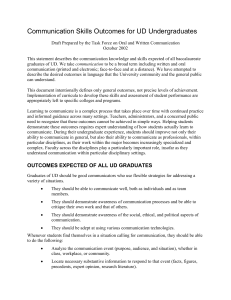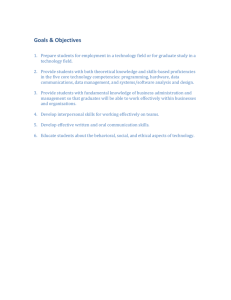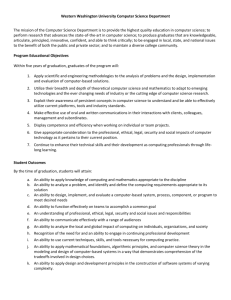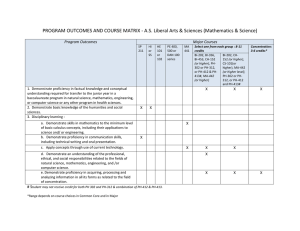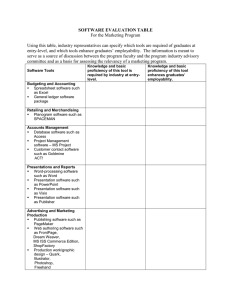AS Degrees: (1) Liberal Arts & Sciences (Mathematics & Science) (LS1)
advertisement
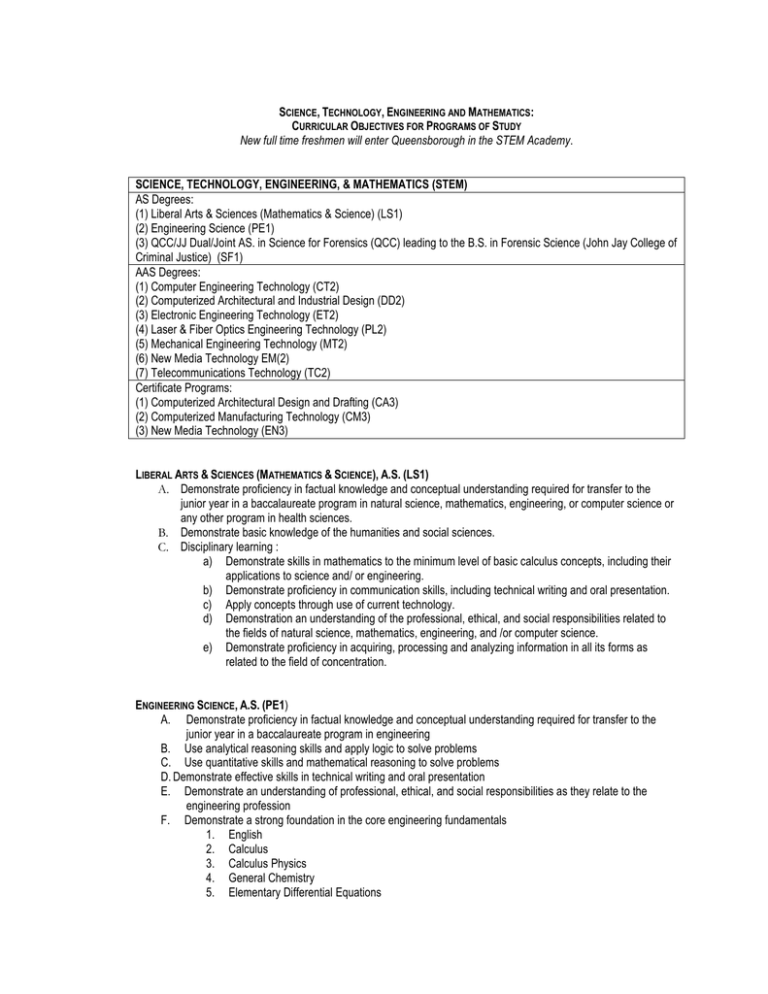
SCIENCE, TECHNOLOGY, ENGINEERING AND MATHEMATICS: CURRICULAR OBJECTIVES FOR PROGRAMS OF STUDY New full time freshmen will enter Queensborough in the STEM Academy. SCIENCE, TECHNOLOGY, ENGINEERING, & MATHEMATICS (STEM) AS Degrees: (1) Liberal Arts & Sciences (Mathematics & Science) (LS1) (2) Engineering Science (PE1) (3) QCC/JJ Dual/Joint AS. in Science for Forensics (QCC) leading to the B.S. in Forensic Science (John Jay College of Criminal Justice) (SF1) AAS Degrees: (1) Computer Engineering Technology (CT2) (2) Computerized Architectural and Industrial Design (DD2) (3) Electronic Engineering Technology (ET2) (4) Laser & Fiber Optics Engineering Technology (PL2) (5) Mechanical Engineering Technology (MT2) (6) New Media Technology EM(2) (7) Telecommunications Technology (TC2) Certificate Programs: (1) Computerized Architectural Design and Drafting (CA3) (2) Computerized Manufacturing Technology (CM3) (3) New Media Technology (EN3) LIBERAL ARTS & SCIENCES (MATHEMATICS & SCIENCE), A.S. (LS1) A. Demonstrate proficiency in factual knowledge and conceptual understanding required for transfer to the junior year in a baccalaureate program in natural science, mathematics, engineering, or computer science or any other program in health sciences. B. Demonstrate basic knowledge of the humanities and social sciences. C. Disciplinary learning : a) Demonstrate skills in mathematics to the minimum level of basic calculus concepts, including their applications to science and/ or engineering. b) Demonstrate proficiency in communication skills, including technical writing and oral presentation. c) Apply concepts through use of current technology. d) Demonstration an understanding of the professional, ethical, and social responsibilities related to the fields of natural science, mathematics, engineering, and /or computer science. e) Demonstrate proficiency in acquiring, processing and analyzing information in all its forms as related to the field of concentration. ENGINEERING SCIENCE, A.S. (PE1) A. Demonstrate proficiency in factual knowledge and conceptual understanding required for transfer to the junior year in a baccalaureate program in engineering B. Use analytical reasoning skills and apply logic to solve problems C. Use quantitative skills and mathematical reasoning to solve problems D. Demonstrate effective skills in technical writing and oral presentation E. Demonstrate an understanding of professional, ethical, and social responsibilities as they relate to the engineering profession F. Demonstrate a strong foundation in the core engineering fundamentals 1. English 2. Calculus 3. Calculus Physics 4. General Chemistry 5. Elementary Differential Equations QCC/JJ DUAL/JOINT AS. IN SCIENCE FOR FORENSICS (QCC) LEADING TO THE B.S. IN FORENSIC SCIENCE (JOHN JAY COLLEGE OF CRIMINAL JUSTICE) (SF1) A. B. Students will communicate effectively through reading, writing, listening and speaking Students will demonstrate competency in the concepts and methods of the foundation mathematics and sciences courses required for transfer to the junior year in Forensic Science at John Jay College: general chemistry, organic chemistry, general biology, calculus, and calculus physics. C. Students will apply concepts learned in the classroom and make conclusions based on scientific thinking. D. Students will work collaboratively in the laboratory to provide reasonable analysis of data obtained and to solve problems E. Students will integrate the knowledge and skills gained in previous courses with subsequent courses to establish an all-around scientific background. F. Students will demonstrate an understanding of professional, ethical, and social responsibilities as they relate to the sciences and forensic science. COMPUTER ENGINEERING TECHNOLOGY, A.A.S. (CT2) A. Career Preparation and Advancement: Graduates will demonstrate mastery of the knowledge and skills needed for entry into or advancement in the field of Computer Engineering Technology B. Engineering Competence: Graduates will be competent technicians with problem solving and design skills, and have the ability to apply mathematics, science and modern engineering software to solve electrical and computer engineering technology problems. C. Professional Skills: Graduates will have strong communication skills, and the ability to work successfully in teams in industry. D. College Transfer: Graduates will meet the requirements for transfer into the junior year of a baccalaureate program in engineering technology. E. Well-rounded Education: Graduates will demonstrate respect for diversity and knowledge of contemporary professional, society, ethical, and global issues, and they will engage in life-long learning. COMPUTERIZED ARCHITECTURAL AND INDUSTRIAL DESIGN, A.A.S. (DD2) A. Meet requirements for successful transfer into the junior year of a Baccalaureate program B. Meet requirements for successful entry into the job market C. Master the knowledge, techniques, skills and modern tools of the discipline a. Generate and interpret engineering drawings b. Use a PC to generate CAD drawings D. Identify, analyze and solve technical problems E. Demonstrate creativity in the design process F. Communicate effectively in reading, writing and speaking G. Identify concepts and methods of mathematical and physical sciences and make judgments about contemporary issues in science and technology H. Function effectively on teams ELECTRONIC ENGINEERING TECHNOLOGY, A.A.S. (ET2) A. Career Preparation and Advancement: Graduates will demonstrate mastery of the knowledge and skills needed for entry into or advancement in the field of Electronic Engineering Technology B. Engineering Competence: Graduates will be competent technicians with problem solving and design skills, and have the ability to apply mathematics, science and modern engineering software to solve electrical and computer engineering technology problems. C. Professional Skills: Graduates will have strong communication skills, and the ability to work successfully in teams in industry. D. College Transfer: Graduates will meet the requirements for transfer into the junior year of a baccalaureate program in engineering technology. E. Well-rounded Education: Graduates will demonstrate respect for diversity and knowledge of contemporary professional, society, ethical, and global issues, and they will engage in life-long learning. LASER & FIBER OPTICS ENGINEERING TECHNOLOGY, A.A.S. (PL2) A. Career Preparation and Advancement: Graduates will demonstrate mastery of the knowledge and skills needed for entry into or advancement in the field of Laser and Fiber Optics Engineering Technology B. Engineering Competence: Graduates will be competent technicians with problem solving and design skills, and have the ability to apply mathematics, science and modern engineering software to solve laser and fiber optics engineering technology problems. C. Professional Skills: Graduates will have strong communication skills, and the ability to work successfully in teams in industry. D. College Transfer: Graduates will meet the requirements for transfer into the junior year of a baccalaureate program in engineering technology. E. Well-rounded Education: Graduates will demonstrate respect for diversity and knowledge of contemporary professional, society, ethical, and global issues, and they will engage in life-long learning. MECHANICAL ENGINEERING TECHNOLOGY, A.A.S. (MT2) A. Career Preparation and Advancement: Graduates will demonstrate mastery of the knowledge and skills needed for entry into or advancement in the field of Mechanical Engineering Technology B. Engineering Competence: Graduates will be competent technicians with problem solving and design skills, and have the ability to apply mathematics, science and modern engineering software to solve mechanical engineering technology problems. C. Professional Skills: Graduates will have strong communication skills, and the ability to work successfully in teams in industry. D. College Transfer: Graduates will meet the requirements for transfer into the junior year of a baccalaureate program in engineering technology. E. Well-rounded Education: Graduates will demonstrate respect for diversity and knowledge of contemporary professional, society, ethical, and global issues, and they will engage in life-long learning. NEW MEDIA TECHNOLOGY, A.A.S (EM2) A. Demonstrate an understanding of and a proficiency in using Internet-based technologies for the design, development, maintenance, and support of such digital media as hyperlinked text, static and moving imagery, audio, video, and multiple interfaces of Web based media. B. Demonstrate understanding and proficiency in technology related to Art and Music. C. Recognize the need for, and demonstrate the ability to, engage in life-long learning with an understanding of contemporary social and ethical issues in a diverse setting. D. Demonstrate an understanding of professional and ethical responsibility. E. Communicate effectively in written, oral, and electronic media and function effectively on teams. F. Demonstrate employment competencies through cooperative education experiences. TELECOMMUNICATIONS TECHNOLOGY, A.A.S. (TC2/TX2) A. Demonstrate proficiency in factual knowledge and conceptual understanding required for transfer to the junior year in telecommunications or a related discipline. B. Use quantitative skills and mathematical reasoning to solve problems in physics, algebra and trigonometry and telecom related disciplines C. Use analytical reasoning skills and apply logic to solve applied science problems D. Demonstrate effective skills in written and oral presentation E. Demonstrate an understanding of professional and ethical responsibility F. Demonstrate a strong foundation in: a. Electric circuits b. Analog and digital circuits c. Voice and data communications d. Telecommunications systems CERTIFICATE PROGRAM IN COMPUTERIZED ARCHITECTURAL DESIGN AND DRAFTING (CA3) A. Students will meet requirements for successful entry into the job market B. Students will master the knowledge, techniques, skills and modern tools of the discipline a. Generate and interpret engineering drawings b. Use a PC to generate CAD drawings c. Demonstrate proficiency in using the latest releases of design software and state-of the art hardware C. Students will identify, analyze and solve technical problems CERTIFICATE PROGRAM IN COMPUTERIZED MANUFACTURING TECHNOLOGY (CM3) A. Students will demonstrate competency in the fundamentals of manufacturing B. Students will demonstrate proficiency in using industrial quality hardware and software used in computeraided design (CAD), computer numerical control (CNC), computer-assisted manufacturing (CAM), and computer integrated manufacturing (CIM). C. Students will demonstrate employment competencies through cooperative education experiences. CERTIFICATE PROGRAM IN NEW MEDIA TECHNOLOGY (EN3) A. Demonstrate an understanding of and a proficiency in using Internet-based technologies for the design, development, maintenance, and support of such digital media as hyperlinked text, static and moving imagery, audio, video, and multiple interfaces of Web based media. B. Demonstrate understanding and proficiency in technology related to Art and Music. C. Recognize the need for, and demonstrate the ability to, engage in life-long learning with an understanding of contemporary social and ethical issues in a diverse setting. D. Demonstrate an understanding of professional and ethical responsibility. E. Communicate effectively in written, oral, and electronic media and function effectively on teams. F. Demonstrate employment competencies through cooperative education experiences. Updated 3/3/09
